by Nick McIndoe
Although known as the seabird capital of the world, New Zealand also has a large number of endemic (found nowhere else on Earth) forest, wetland, and alpine birds. With March being Whio (blue duck) Awareness Month, I visited Orana Wildlife Park to learn about the important conservation work they are doing with whio, and along the way also discovered pāteke (brown teal) and North Island brown kiwi.
U.S. ecologist Jared Diamond, once said, “New Zealand is as close as we will get to the opportunity to study life on another planet.”
How is this so? Isolated since breaking away from the supercontinent Gondwana around 80 million years ago, New Zealand’s plant and animal life has developed down a unique evolutionary path. The level of endemism amongst New Zealand’s flora and fauna is amongst the highest in the world- examples include the tuatara, kiwi, kakapo, native frogs and giant carnivorous land snails.

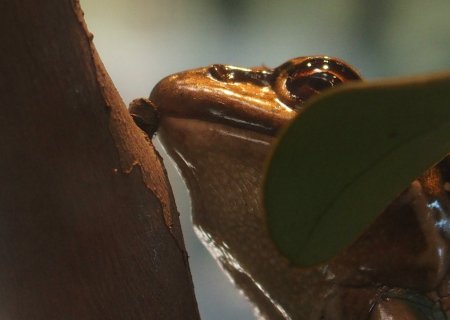
A young tuatara (top) and a bell frog at Christchurch’s Orana Wildlife Park.
This isolation did come at a cost however. The absence of mammalian predators meant that many of our native species became defenceless against attack- for example, the kiwi cannot fly and nest on the ground.
When humans (first Maori and then European settlers) arrived in New Zealand, introduced mammals came with them: rats, possums, stoats, ferrets, weasels, deer, pigs, mice, cats and dogs took a heavy toll as they either preyed upon or competed with New Zealand’s largely defenceless native species. Human activities such as felling and burning vegetation and draining wetlands also destroyed many native species’ habitats.
Many species such as the moa, the South Island kokako and the world’s largest-ever eagle, the Haast’s eagle became extinct, while others such as the whio, pāteke and kiwi remain on the brink to this day.
Christchurch’s Orana Wildlife Park is committed to reversing this trend. In fact, Marketing, Public Relations and Visitor Services Manager, Nathan Hawke, points out that at least 20 New Zealand native species live wild on Orana’s grounds. Modern day zoos should be all about animal welfare, conservation, education and research. With native wildlife in such trouble, New Zealand zoos have a unique opportunity to show that they are world leaders in “breed for release” conservation initiatives.
Orana Wildlife Park is owned and operated by the Orana Wildlife Trust- a registered charitable trust and not-for-profit organisation – and is a proud member of the Zoo Aquarium Association Australasia (ZAA), ZAA NZ Inc (the New Zealand Branch of ZAA) and World Association of Zoos and Aquariums (WAZA).
During Whio Awareness Month (March), Orana’s Native Fauna Manager, Alyssa Salton, and colleague, Leigh Percasky, travelled to the central North Island to assist in the release of 12 captive raised whio. Despite having raised over 50 whio for release, this was the first time that staff from Orana Wildlife Park had ever attended a wild release.
The ducklings were reared at Orana Wildlife Park, Peacock Springs and Pukaha Mt Bruce. They were released to the wild in the Maunganui o tea o River near Wanganui.
Well done to the Orana team – captive facilities play an important role in not only producing and rearing these special ducks, but also in raising public awareness of their plight. And Orana Wildlife Park is planning to do more for whio: they are hosting an education workshop for teachers run by Whio Forever. They are also excitedly anticipating more baby whio in the upcoming breeding season, and are keen to “breed and release” South Island whio as well. Although the North Island and South Island whio are genetically distinct, they are not classified as subspecies; they are, however, treated as separate management units.
Orana Wildlife Park currently has one breeding whio pair, located in the Park’s beautiful walk-through lowland aviary. Eggs can be laid from July to December, says Alyssa, “Here in captivity we feed them a specially formulated pellet that was developed by Massey University. They also get live food, particularly during breeding season – crickets, locusts and similar.
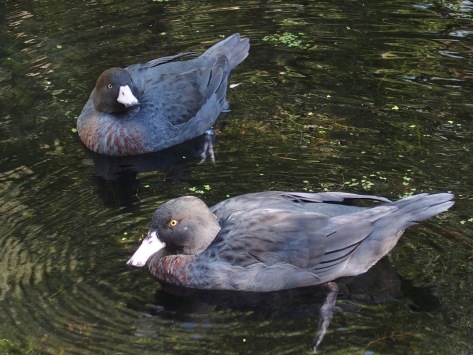
The whio breeding pair located in the beautiful walk-through lowland aviary at Orana Wildlife Park.
“In the wild, their fleshy bill allows them to scrape against rocks and dislodge invertebrates to eat.”
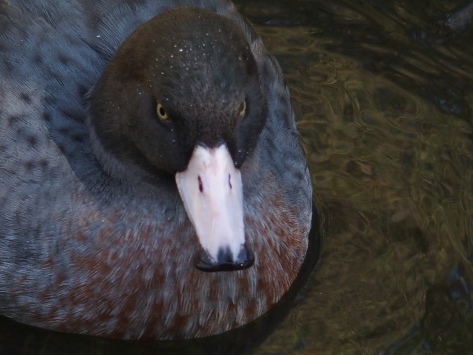
The whio’s unusual but highly effective bill has a soft lip at the end, which the duck uses to scrape invertebrates off rocks.
Although they may not know it, most, if not all New Zealanders would have seen a whio, if only in artistic form – the blue duck is depicted on the reverse side of the New Zealand $10 banknote. In the North Island, the Maori name whio (pronounced “fee-oh”) or ko whio (South Island) depicts the call of the male bird, and they are a taonga (treasured) species. Maori have a strong cultural, spiritual and historic connection with whio.
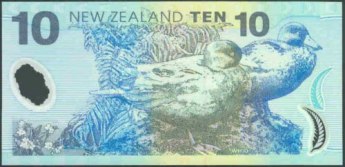

The New Zealand $10 dollar banknote, old design (top) and new feature the whio (Source: Wikipedia).
The whio is one of New Zealand’s “ancient” bird species that unfortunately has suffered at the hands of predation and habitat destruction. Current estimates put the population at less than 3,000 individuals. The International Union of Conservation for Nature (IUCN) classify the whio as Endangered, while the Department of Conservation (DOC) species threat classification is Nationally Vulnerable. This makes the ducklings (and any future ones) from Orana Wildlife Park, an important addition to the wild population. They are beautiful ducks and it would be a real tragedy if we were to lose them forever!
Saving whio presents some unique challenges. They are one of only four torrent water (fast flowing water) duck species worldwide. However, they are river specialists – they are born with enormous webbed feet which they can collapse like a folded umbrella to create less drag, allowing the ducks to pull themselves through fast-flowing water.
Whio are considered an “indicator” species for the state of New Zealand’s rivers – if whio are present, the river is said to be in a very healthy state. Therefore, saving the whio, means saving their habitat too.
Complicating matters, is that researchers have recently discovered whio to be better fliers than originally thought. An attempt to relocate two pairs of adult ducks from Ohakune to Mt Taranaki went wrong when the ducks returned to their home territory over 100 km away, in a matter of days!
Closer to home, Auckland Zoo celebrated Whio Awareness Month with their annual ‘Blue Duck Race’- 500 rubber blue ducks were ‘released’ into the Zoo stream for a race over the weekend of 5 and 6 March.
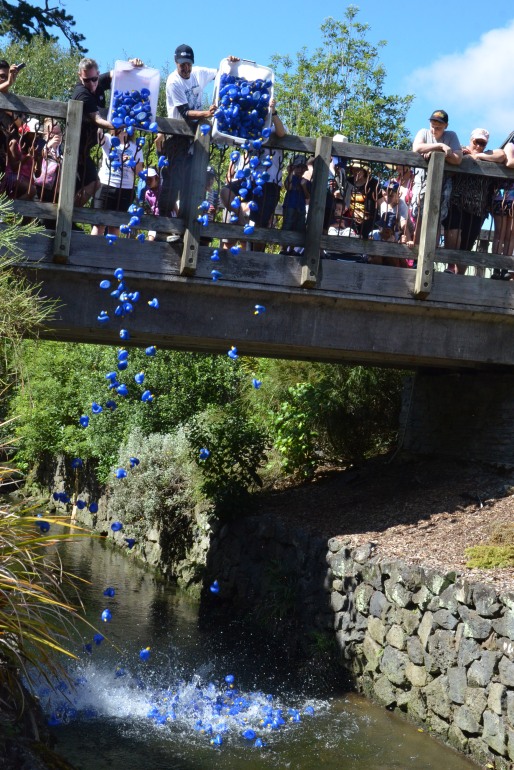
500 rubber blue ducks are ‘released’ into Auckland Zoo’s stream for a race to celebrate Whio Awareness Month (Photo: Auckland Zoo).
Meanwhile the ‘Orana pair’ seem to have lost interest in us, so Alyssa offers to show me some of the other native conservation projects that the Park is working on.
Like the whio, the brown teal or pāteke is an endemic New Zealand waterfowl, and is a “Very underrated bird”, says Alyssa.
Unlike whio, pāteke do not live in torrent water, instead, they prefer swamplands and kahikatea forest where there are slow, meandering creeks and overhanging, secretive banks.
Like the whio, the pāteke’s numbers have fallen from habitat destruction, predation and poaching, and it is now the rarest waterfowl species on mainland New Zealand. Estimations put the number of wild individuals at between 2,000 and 2,500.
Orana Wildlife Park also has a “breed and release” programme in place for pāteke, and so far, more than 80 have been released into the wild. The teal spend around eight weeks at The Isaac Conservation and Wildlife Trust in Christchurch, before their release into the wild.
I agree with Alyssa – they are beautiful ducks. “Don’t be fooled though!” she says, “They have a massive personality. The males especially can be feisty as they are highly territorial.”

The brown teal or pāteke is another beautiful, but endangered New Zealand endemic waterfowl- just look at that chestnut colouration on the male’s breast (rear).
Orana Wildlife Park is involved in the captive component of the North Island brown kiwi Recovery Programme, meaning that kiwi are bred on-site. Last year, eight kiwi from Orana were transferred to the wild and two newly created pairs have showed promising signs that they will hopefully produce eggs this year.
The Park also has an important role in advocating kiwi conservation – the kiwi house is open from 11 am daily, with a daily feed/talk at 1.30 pm.
There are four distinct forms of North Island brown kiwi, plus four other kiwi species. The North Island brown kiwi is considered Nationally Vulnerable with around 25,000 individuals remaining in the wild. This may seem like a lot, however, the population is decreasing by approximately 2-3% a year.
The kiwi is New Zealand’s national icon, so it would be an absolute tragedy if they went extinct, something which experts are warning could happen within two generations if the current decline continues. The biggest threats facing kiwi are stoats and dogs.
This is where advocacy is so important- stressing that dog owners must keep their dog on a leash at all times.
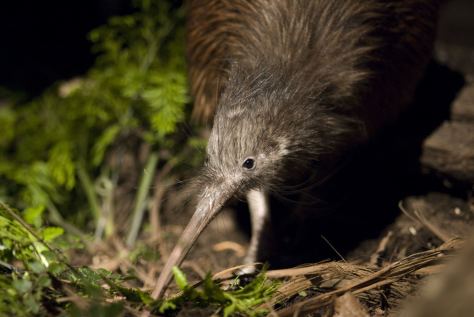
North Island brown kiwi (Photo: Orana Wildlife Park).
Orana Wildlife Park has a comprehensive native fauna collection, in beautiful surroundings, enabling you to see many of New Zealand’s unique native treasures.
Captive facilities like Orana Wildlife Park, through “breed and release” programmes and advocacy are vital to the survival of New Zealand’s native fauna. The Park provides a place where the public can view New Zealand’s diminishing native wildlife and hopefully, become passionate about and engaged in assisting conservation efforts.
As Alyssa says, “That is one of the best parts of our job, seeing birds we have raised being released into the wild, it is very gratifying.”
The Zoological Society of Auckland would like to thank Orana Wildlife Park, especially Nathan Hawke and Alyssa Salton for their assistance with this article, and also Jane Healy from Auckland Zoo for supplying a ‘Blue Duck Race’ photo.
